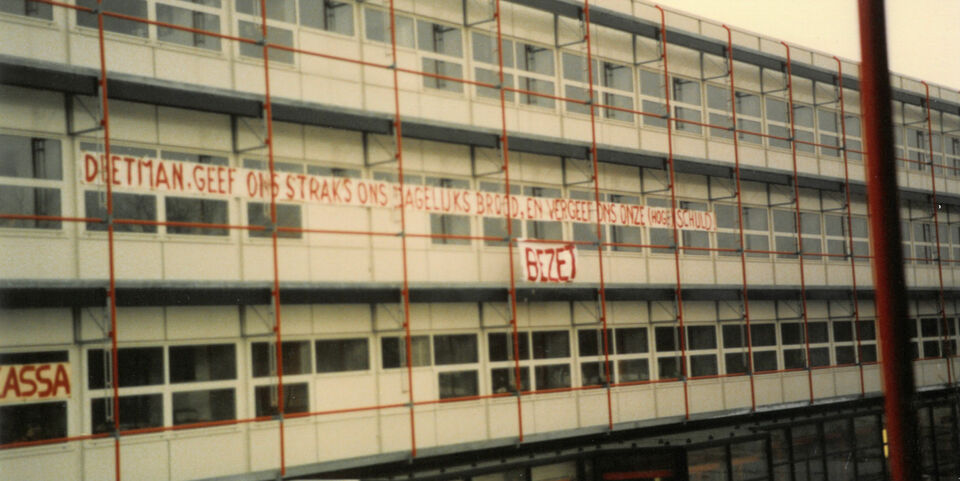In 1986, students didn’t occupy rooms, but an entire building
Last week, climate activists from University Rebellion occupied meeting rooms in Atlas for the second time within a short period. Occupations have also become a regular occurrence at other universities in recent weeks. This type of demonstration is not a new phenomenon: the university has been occupied by discontented students many times in the past. One example was in 1986, when student union ESVB used this same method to get the Executive Board to speak out against the plans for a new student grant law. Gudule Martens was one of the occupiers at the time.
“We headed to the administration building (now Traverse on Laplaceplein, Ed.) early in the morning with crates of beer, sleeping bags and bike chain locks,” Martens recalls. “We only managed to secure those chain locks just in time: security was already pulling on the door.” On Tuesday, January 14, 1986, members of student union ESVB - including Martens, who was studying Architecture at the time - occupied the entire administration building. Their goal was to get the Executive Board to admit that its members were opposed to the new student grant plans - just like the students.
“We knew they were opposed to the plans because they had told us so, but they kept quiet. We thought that was ridiculous.” And so, the Executive Board soon conceded and released a statement the next morning together with the students. The Board agreed to raise the criticisms of the draft bill during a meeting with umbrella organization VSNU (now called UNL, Ed.) and possibly take the matter up with education minister Wim Deetman afterward. The students then left the administration building without incident and “left everything neat and tidy,” says Martens.
Violence from an unexpected quarter
No violence or evacuation took place, although Martens says security would have dragged the students out of the building if the chain locks had not been in place on time. However, the students did receive threats of violence from an unexpected quarter: electrical engineering students disagreed with the protests and formed violent squads in an effort to remove the occupiers from the building. “We had the good sense to send all the women to the door. Those electro guys just stood there bumbling and asked why we were occupying the building when we weren’t even students ourselves. Only five percent of TU/e students were women back then, but in the student union, that percentage was considerably higher.” Before long, the “E-students” backed off.
Back to the present day. When Martens, now a creative entrepreneur and social designer, saw the footage of last week's occupation, she was shocked to see the students being forcefully removed from the boardroom. “And I understand that it wasn't even the police who dragged them out. So that makes me wonder: why did they do that? And also, why didn’t those students have bike chain locks? Just kidding, of course.” Although the security staff's actions angered her, Martens thinks the incident helped the students’ cause. “It drew attention and that’s a good thing. After all, that's kind of the purpose of a demonstration like this.”
Certain kind of inconvenience
The statement about the incident released by the Executive Board last Monday left her feeling bewildered. More particularly, the reason given for all the pushing and shoving that occurred. The Executive Board writes that activists “forced their way into the boardroom without permission and despite the restrictions previously shared, past security guards standing in the doorway.” Martens: “The whole point of demonstrating is that you don’t go asking for permission. What use is it to demonstrate somewhere where you don’t bother anyone? You have to create a certain kind of inconvenience to receive attention. TU/e has more than enough empty meeting rooms, so as university administration, I’d say: go ahead and take that room.”
Does she feel that old familiar urge again when she sees these students protesting? “I do, and I think it’s a very good thing that students are taking action again. They’ve had a lot taken away from them in recent years, such as the student grants we fought so hard for back then. We made a stand not to let them take those from us, and we were successful.” Therefore, she would advise students to take an example from successful actions in the past. She refers to the famous occupation of the Maagdenhuis in Amsterdam. Although Martens admits: “That went a bit too far. But it sure had impact.”
Personally, she has her eyes on Scientist Rebellion for the moment. “It’s super interesting. Seeing those nerds in white lab coats gluing themselves to a Shell office. I love it! Scientists have been warning us about the climate problem for twenty years now and still no action is taken. Even though we’re all aware of the situation.” The same applies to TU/e, she says, and this is where she draws a parallel with the occupation more than 35 years ago. According to Martens, the Executive Board agreed with the protesters at the time. “They knew what was right. Just like they know now that we can't go on like this.”





Discussion